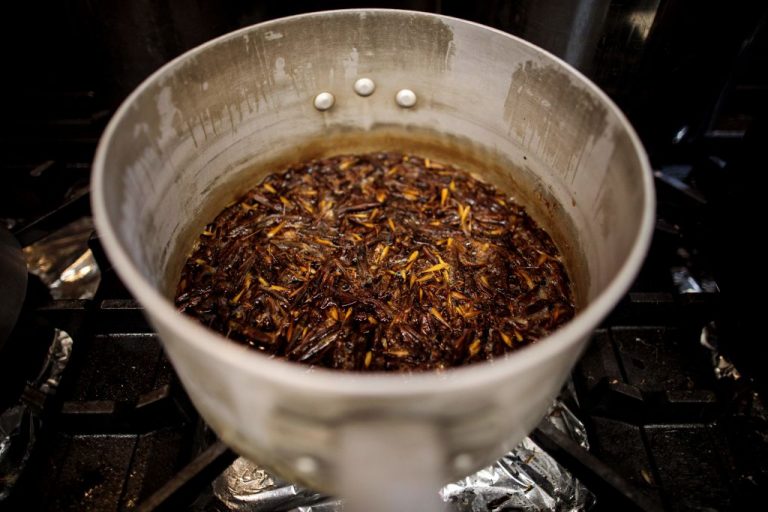This week, students at four primary schools in Wales will be offered insects such as crickets, grasshoppers, silkworms, locusts and mealworms to eat in an effort by researchers to determine their appetite for “alternative proteins.”
Researchers are hoping to gain insight into how to best educate children on the environmental and nutritional benefits of edible insects and in turn, hope to influence their parents’ behavior concerning the dinner table.
The project will employ surveys, workshops, interviews and focus groups to gauge students’ understanding and experiences concerning alternative proteins.
One of the schools participating in the research is Roch Community Primary School in Pembrokeshire.
Carl Evans, the school’s Headteacher, said the research will provide students with insight into the connection between their local community and food production.
Success
You are now signed up for our newsletter
Success
Check your email to complete sign up
“There is an important connection between our local community, food production and wider global issues surrounding sustainable development,” said said, adding that, “These issues are important to children, but also difficult to make sense of an can often be confusing for them.”
One researcher involved in the study, Christopher Bear, of Cardiff University wants children to consider edible insects as a choice for nourishment today rather than in the future. “We want children to think about alternative proteins as real things for now, rather than just as foods for the future, so trying some of these foods is central to the research,” he said.
“Although edible insects are — for now — not sold widely in the UK, they form part of the diets of around 2 billion people worldwide. Much of this is in parts of the world where they are part of long-standing culinary traditions. And they are increasingly popular elsewhere,” Bear said.
According to a 2020 study by the International Platform of Insects for Food and Feed (IPIFF) an estimated 9 million Europeans ate insects in 2019 and proponents believe this number will increase considerably to 390 million by 2030.
International organizations such as the United Nations have promoted the use of insects for food for their potential environmental and nutritional benefits and as a strategy to address global hunger and malnutrition.
Researchers seek to influence parents’ behavior
Verity Jones, of the University of the West of England in Bristol, who is involved in the study, says children have significant influence over what their parents serve at the dinner table.
“Many children have the power of pester, so in some cases can be great agents of dietary change within the family,” she said, arguing that minute bits of insects have already found their way into many of the foods people eat.
“Everyone eats insects everyday – there’s over 30 parts of bugs in every 100g of chocolate … bread, fruit juices, hops … you name it, you’re eating insects,” she said.
“And I have found that, once children know that insects are already, by the very nature of processing, in many of the foods we eat; and are assured that they won’t become ill from eating them, they are very open to trying [them],” Jones said.
Jones says that how edible insects are served up plays an important role in whether or not someone will take a bite.
“All research, for adults and children, indicates whole insects are off-putting, but ground-up insects within foods are very acceptable. No one likes the idea of having a crunchy bit of wing or antenna between their teeth. But, in fact, children were more likely to choose food containing edible insects over usual meat products on a matter of sustainable credentials if given the option,” she claims.
Environmental impact
Proponents for insects as food argue that the production of edible insects is much better for the environment than the production of traditional protein sources such as beef, pork, or chicken.
Edible insects are said to be rich in protein, antioxidants, vitamins and other nutrients.
According to a study published in the journal Plos ONE, mealworms produce one percent as much greenhouse gas per kilogram as cows and about 10 percent of a pig’s carbon footprint. House crickets are believed to pollute even less.
Another study, published in the journal of Cleaner Production, found that insect farms emit 75 percent less carbon and use half as much water as poultry farms, per kilogram.
UK consumers are showing an increased demand for not only healthy diets but for sustainable diets as well.
A recent study by the Finder research group concluded that over seven million adults in the UK adhere to a meat-free diet with another six million expressing an intent to shift toward a vegetarian or vegan diet.
People aged 18 to 23 are more likely to consider a meat-free diet than other age groups.
Currently edible insects are considered a “novel food” in the UK, meaning that they need to undergo new safety checks.
However, next month, the Food Standards Agency (FSA) is expected to allow edible insects to be traded in supermarkets and other retailers across the UK on a temporary basis. Full approval is expected to come next year.
Head of food safety policy at the FSA, Michael Wight, said in March, “We are aware that edible insects, as part of the alternative proteins market, can offer benefits, most notable for the environment,” adding that, “We are working hard to support and advise businesses and trade bodies so that they can provide high quality dossiers and evidence as part of their novel food applications.”

















